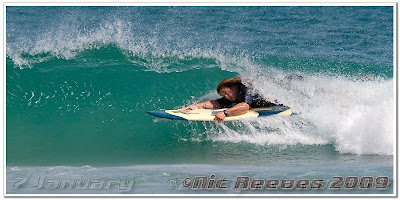From the Otago Daily Times - Friday 23rd January 2009EditorialIt is not surprising the pollution of premier Dunedin beaches St Kilda and St Clair causes such a big stink. The fouling makes the beaches unusable under certain conditions, and is an appalling local and national advertisement. Dunedin, with its wildlife, natural beauty, and history, cannot even keep its own effluent from its own front door step.
All that is about to change because commissioning is taking place of the $37 million, 1.1km outfall from Tahuna. While a $67 million secondary treatment plant is to follow, the outfall alone is expected to make a big difference to the immediate problems.
Dunedin's waste from the main metropolitan area at present passes through the Tahuna plant, where screening takes place. It then, still with plenty of pathogens on board, discharges from Lawyers Head. With unfavourable winds and seas the plume of pollution washes back along the beaches, an event that happens far too often, especially in the summer months.
Even worse, every few years fats accumulated in the system are flushed out and can thickly coat the sand when heavy rains follow a long dry spell and the sea flows the "wrong" way.
The "primary" treated effluent (about 46 million litres a day) is now beginning to flow through the new outfall pipe and diffuse and disperse into reasonably deep (20m to 25m) water.
Given prevailing currents, any remaining material should drift northeast rather than southwest back on to the beaches. Council staff, the people of Dunedin and especially surfers and swimmers will certainly be hoping that this is so.
In the meantime, the council will be testing the effectiveness of the dispersal in the sea and on the shoreline before proceeding to the next stage to chlorinate the effluent.
The outfall had been due for completion late in 2007 and, after weather and technical difficulties, its commissioning is not before time.
Many in the council had believed that the outfall and the planned level of treatment should be enough. The dumping of sewage after only primary treatment into the ocean at any distance, however, arouses much concern and opposition.
For its part, the Otago Regional Council, in its resource consent role, insisted on secondary treatment. The city, therefore, had no choice but to push ahead with this. Planning is under way, the new plant will also be at Tahuna, and completion is scheduled for September 2011. The advanced treatment will squeeze more sludge from the sewage and treat it with ultraviolet rays. Ideally, the sewage would be treated to far higher levels - and we would be happy to drink the results. That, though, would incur vast expense, well beyond the capabilities of a small city like Dunedin. As it is, the cost of the new scheme per household already exceeds that estimated for the Otago Stadium.
Householders in an average (mean) property in Dunedin are, according to council estimates - and with about 9% interest being charged - expected to be faced with an extra $66 a year over a 20-year loan for the council's share of stadium capital costs. That would fall to about $57 for the householders in a median-value (the middle of the range) property. The most expensive properties would pay much more and the cheapest less. Yet the combined effect on the rates of the new sewage outfall and plant capital costs over a 20-year loan (also at 9% interest, although this shows signs of falling considerably) would be about $85 a household a year. Unlike the stadium costs, drainage and sewage would not be combined with council company profits and losses, denying the opportunity for tax savings. Sewerage costs also differ in they they are collected as fixed charges for each house (rather than on capital value), meaning homes all pay the same.
The cost of the pipeline and the secondary treatment could then rise above $100 a year once all the extra yearly operating costs are taken into account. The stadium figures also exclude any operating losses the stadium might make and which ratepayers, one way or another, might be forced to bear. There remains, too, a potentially costly sting in the tail of secondary treatment, for work is still proceeding on the most effective, economic and environmentally acceptable way of dealing with all the extra "sludge" which will be produced. Burning it - a common solution - has obvious disadvantages; fertiliser production options have severe drawbacks; and dumping is unsatisfactory.
Dunedin is long overdue in dealing to its disgraceful beach pollution, and few should begrudge what must be seen as a heavy impost to provide a basic and essential service.






































































